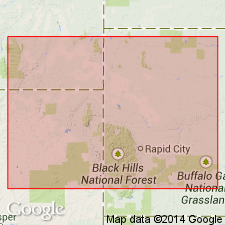
- Usage in publication:
-
- Liscom Creek Member
- Modifications:
-
- Named
- Dominant lithology:
-
- Sandstone
- Siltstone
- AAPG geologic province:
-
- Williston basin
- Powder River basin
Summary:
Named as the lower member (of 3) of the Fall River Formation, upper formation of Inyan Kara Group. Unconformably overlies Lakota Formation of Inyan Kara. Gradationally underlies the newly named Morton Member of Fall River. Named for the Carter Oil Co. No. 1 Liscom Creek in center SW 1/4 SW 1/4 sec 15, T1N, R45E, Custer Co, MT, in the Williston basin; this well is the type well. Extends eastward across eastern MT into northern WY, western SD, and southwestern corner of ND of the Powder River and Williston basins. Isopach map; is more than 100 ft thick in eastern MT; thins eastward. Consists of 96 ft of massive, buff, fine- to medium-grained sandstone between 5,612 and 5,708 ft in type well. On outcrop in southern Black Hills, member is tabular, ripple-marked, warm-tracked sandstone and gray carbonaceous, laminated siltstone or shale. Some reworked Lakota deposits present in Liscom Creek. Was probably a complex deltaic deposit in Black Hills. Of marine or littoral marine origin. Some barrier bar sandstones. E-log. Cross sections. Early Cretaceous age. This is a study of subsurface data over the entire report area and of surface data from outcrops around the Black Hills.
Source: GNU records (USGS DDS-6; Denver GNULEX).
For more information, please contact Nancy Stamm, Geologic Names Committee Secretary.
Asterisk (*) indicates published by U.S. Geological Survey authors.
"No current usage" (†) implies that a name has been abandoned or has fallen into disuse. Former usage and, if known, replacement name given in parentheses ( ).
Slash (/) indicates name conflicts with nomenclatural guidelines (CSN, 1933; ACSN, 1961, 1970; NACSN, 1983, 2005, 2021). May be explained within brackets ([ ]).

